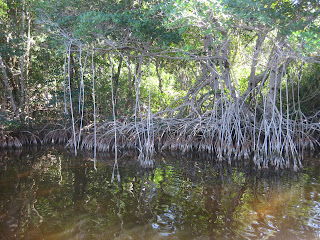



The first thing most people think of when they think of the Everglades is alligators. They are definitely here, after a period of near extinction, they are back and thriving. But the Everglades is a wildly diverse ecosystem. There is an incredible variety of plants and animals and a whole series of identifiable ecological niches across 1.6 million acres of glade.
The National Park Service describes the Everglades ecosystem thus: "Water, tropical climate, elevations, and fire are the essential ingredients that make the Everglades unique in North America. Water is the rejuvenating life blood. The climate--frost free, humid and warm--nurtures a mix of both temperate and tropical inhabitants. Slight changes in inches of elevation diversify
what seems to be a monoton- ously flat landscape. Fire, that much maligned element, can restore health and protect diversity."
There are really only two seasons in the Everglades: wet and dry. This, the dry season, will end in May. The wet season runs from June to November. Water levels in the 'Glades can vary as much as four feet (Picture 2). The prime tourist season is during the dry season. You can actually walk through many areas of the sawgrass now and wild life is concentrated in those places that still have standing water. Fresh water flows from Lake Okeechobee in the north through a tabletop-flat sea of sawgrass to the estuaries on the southern Florida coast. The water may only move a hundred feet a day--a very slow-flowing river. There it mixes with seawater to form brackish, shallow bays and waterways. One can determine the degree of brackishness by the species of mangrove growing at any point. An inch of elevation difference may make create an environment for a different species of mangrove! Picture 3 shows mangrove roots (both aerial and prop).
Relatively little of the Everglades is accessible by road. If you want to really see the 'Glades, you will need to take a pontoon, an airboat, a canoe, or hike.
Caution would seem to the order of the day if you are moving about the 'Glades. Among the forty-some species of snakes in the Everglades, four are poisonous: diamondback and pygmy rattlesnakes, water moccasins, and coral snakes. Then there are the Burmese python, the Florida panther, alligators, and crocodiles.
In addition the plant life can be deadly. For example, the manchineal tree (picture 3) has beautiful shiny green leaves and apple-like fruit. Two bites of the fruit or rainwater running off the leaves, however, can be fatal.



















































